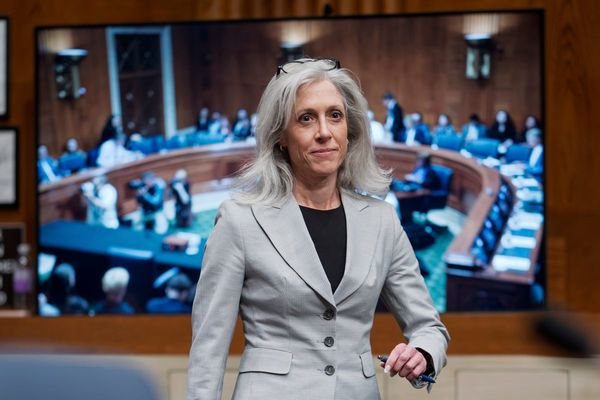John Chiminski knows he doesn't fit the traditional image of a corporate bigwig. And the Catalent CEO is not about to change.
As chairman and chief executive of Catalent, a Somerset, N.J.-based drugmaker and global provider of gene therapies, Chiminski radiates authenticity. He sets high standards for his team. But he's also approachable and relatable to the company's nearly 18,000 employees.
With his longish hair, beard and cowboy boots, the 58-year-old comes across as a friendly colleague rather than an intimidating chieftain. He even sports a tattoo on his forearm that reads "We The People."
"If I'm sleeveless, people see that and think, 'Wow, this is a company where I can be myself,' " said Chiminski, who became Catalent's CEO in March 2009. He took over just one week after the stock market hit bottom during the Great Recession.
"You can't lead an organization without everyone's support and trust. And that comes from being consistent and authentic. We want people to be their authentic selves, within our values," he said.
Stay True To Yourself Like The Catalent CEO
When preparing for Catalent's initial public offering in 2014, Chiminski was told to adopt the look of a clean-cut executive. He refused.
"Our investment banker heard from my owners, a private equity firm, that they'd like me to shave my beard and not wear cowboy boots on the road show," Chiminski recalled. "I said no, that I'd rather shave my head."
Chiminski may not have looked the part of a conventional CEO. But his deep grounding in the pharmaceutical business and diversified medical diagnostics, along with his vision for Catalent's growth, helped make the IPO a success. The stock is up more than 440% since then vs. 140% for the S&P 500, says data from S&P Global Market Intelligence and MarketSmith.
In his efforts to promote diversity and inclusion within Catalent, Chiminski seeks to set a tone of acceptance that enriches the organizational culture. He often hears from staffers about how his comfortable-in-my-own-skin appearance signals to them that they're welcome as they are.
Follow Three Keys To Success Like The Catalent CEO
Chiminski came to appreciate the power of culture during his nearly 21-year career at GE Healthcare, a unit of General Electric. It culminated in a two-year stint as president and chief executive of GE Medical Diagnostics, a global business with $1.9 billion in sales.
"I was at GE when it was one of the world's most admired companies," he said. "GE was all about talent management and leadership. It had great processes with strategy execution. So I was formed under that model."
But when he arrived at Catalent in 2009, it was a far cry from GE. "We were a very average company with some good assets," he said. So he set out to transform the organizational culture.
For starters, he defined key drivers of the company's success — excellence, innovation and growth — and reinforced their importance at every opportunity. He instilled a patient-first mindset and prioritized patient safety across all levels of Catalent.
Turn Setback Into Opportunity
A few years later, Chiminski confronted a crisis that ultimately advanced the transformation of the culture. Regulators closed one of the company's drug manufacturing sites due to regulatory compliance concerns.
"I was flummoxed," he said. "It was a fairly dramatic impact on the company; about 10% of our (adjusted cash flow) came from this one site and we made 40 products there."
Chiminski responded by huddling with top executives. He won their buy-in to foster a more unified culture around compliance and manufacturing excellence. He met initial resistance when some managers replied, "Of course, we're already all about patient safety." But he convinced them to step up their game.
From there, he hosted employee meetings at 20 of the company's manufacturing sites around the world. He explained in detail what regulators found and the risks they identified that could have impacted patients (but did not).
"Then we had each site make a commitment to patient first," he said. "At one site, employees all signed a 'Patient-First Wall.' At another, they all signed a big banner. Each site had its own way of promoting" the message.
After a yearlong investigation, the closed site reopened with a renewed patient-first culture. It's now a leader of best practices in drug manufacturing, he says.
Gather Market Data To Innovate
To underscore the need for innovation, Chiminski sought to ignite employees' curiosity. He urged them to observe the marketplace to understand patients' needs and devise creative solutions.
"Innovation is not about tinkering," he said. "It's about making sure our team is curious about what our customers really need and where the market is going."
He introduced an internal program to gather competitive and marketing intelligence. Chiminski streamlined the process of collecting and analyzing information to help Catalent's business units innovate.
"We spend thousands of hours on information gathering to understand the competitive and marketing landscape," he said.
Chiminski realizes that the push to innovate can backfire if pressures mount and the culture fizzles. Recently, he bought the book "Flying Blind" and plans to give it to his leadership team as a cautionary tale of what can go wrong. In the book, author Peter Robison describes the decline of Boeing — and its culture — amid the 737 MAX crashes.
Value Key Partnerships
Because partnerships drive innovation in the pharmaceutical business, Chiminski values collaboration. He puts in the time to build trust and rapport with other drugmakers.
Vlad Coric, M.D., recalls how Chiminski cultivated a successful partnership as Coric's firm, Biohaven Pharmaceuticals, worked on a medication to treat acute migraines.
"John's ability to listen, provide clear feedback and regular personal access helped ensure success," said Coric, Biohaven's chair and chief executive. "He didn't have to do all that. He has people who could do that. But he genuinely cares about his partners and his collaborators and, most importantly, the patients."
Chiminski takes every opportunity to convey a patient-first message. He starts every board of directors meeting with a patient success story.
"It's five or 10 minutes to begin every meeting," said Greg Lucier, who serves on Catalent's board. It humanizes the business at hand as board members see the impact of the company's work.
"John also starts every town-hall meeting (with employees) with a patient story," added Lucier, chief executive of Corza Health. "Sometimes it's a video, John interviews the patient or just tells the story. It's very personal to him. It's all part of how he instills a culture of humanity and care."
John Chiminski's Keys:
- Chair and CEO of Catalent, a Somerset, N.J.-based drug manufacturer and global provider of gene therapies.
- Overcame: Taking over the company following an economic downturn and addressing quality issues at a key plant.
- "Innovation is not about tinkering. It's about making sure our team is curious about what our customers really need and where the market is going."







